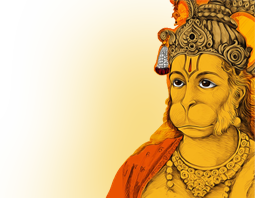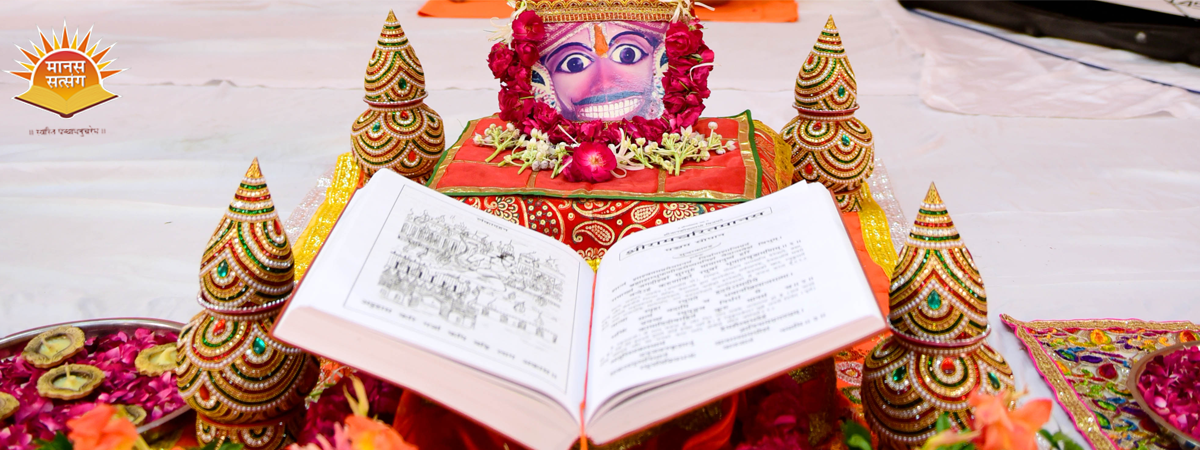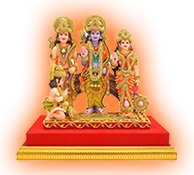


“Sunderkand Katha”
यह चरित कलिमलहर जथामति दास तुलसी गायउ ।
सुख भवन संसय समन दवन विषाद रघुपति गुनगना।
तजि सकल आस भरोस गावहि सुनहि संतत सठ मना ।।
Yah charit Kalimalhar Jathamati Das Tulsi Gaayau I
Sukh Bhavn Sansay Saman Davan Vishad Raghupati Gunaganaa I
Taji Sakal Aas Bharos Gavahi Sunahi Santat Sath Manaa II
The importance of Sunderkand has been described by Goswamiji himself in the concluding part of the volume. It is empowered to wash away the sins of Kalyug. Regular recital, listening and contemplation bless the human beings with profound happiness and bliss. It drives away the fears and illusions of the mind and establishes a peaceful state of being.
The title of this fifth segment of Shriramcharitmanas is interesting as well as intriguing. All the other titles of the segments of this epic are named after either a region or a particular occasion/event or a situation.
For instance
BalKand, Uttarkand – named after the episodes pertaining to the childhood and the episodes of the latter stages of Shri Raghunathji’s life. These sections are named on SITUATIONS.
Ayodhyakand, Aranyakand, Kishkindhakand – these are titled, based on the geographical regions.
Lankakand-
This segment depicts the war that took place in Lanka and therefore is named after that particular event.
Therefore, based on their titles, these six parts or Kand as we call them can easily be identified with what they illustrate. However the title Sunderkand has a special significance. It subtly directs of being termed after a region.
GiriTrikoot Upar Bas Lanka.
As per the ancient records, Lanka was situated on the hills of Trikootachal (its ancient name). This mountain range had three peaks namely -
- Neelachal, Shubelachal and Sundarachal.
It is Sunderachal hills where Ashok Vatika exists. The entire happenings that are projected in Sundarkand evolved in Ashok Vatika – a part of the Sunderachal hills. We can therefore consider that the name Sundarkand is region-based.
Interestingly, we can safely say that the name Sundarkand is situation-based too. As mentioned, this Katha was actually told by Lord Sadashiv to his consort Parvatiji. Sundar means beauty. The narration of this katha literally transformed Lord Shivji to a beautiful meditative state.
प्रभु कर पंकज कपि के सीसा ।
सुमिरि सो दसा मगन गौरीसा ।।
Prabhu Kar Pankaj Kapi ke Sisaa I
Sumiri So Dasaa Magan Gaurisa II
सावधान मन करि पुनि संकर ।
लागे कहन कथा अति सुन्दर ।।
Savdhaan Mann Kari PuniSankar I
Laage Kahan Katha AtiSundar II
The point to be conveyed here is to glorify the immense significance and splendor of Sundarkand whose rendition put Lord Sadashiv himself in a deep meditative state. No doubt, as the name suggests, Sundarkand is eternally divine and beautiful. Thus the name Sundarkand is derived based on its region as well as the condition.
There are many reasons that make Sundarkand beautiful. However the true magnificence of Sundarkand lies in the fact that it revolves entirely around ‘Bhakti’ that is Devotion. Shri Ramcharitmanas personifies Shri Sitaji as an epitome of devotion and dedication. There are many couplets that endorse this fact.
For instance
यथा – लसत मंजु मुनि मंडली मध्य सीय रघुचंदु ।
ग्यान सभा जनु तनु धरे भगति सच्चिदानंदु ।। -२.२३९ रा.च.मा.
Yatha-lasat Manju Muni Mandali Madhya Siya Raghuchandu I
Gyaan Sabha Janu Tanu Dharey Bhagati Sachchidanandu II -2.239 Ra. Cha. Ma
Sundarkand is a devotional journey of Lord Hanumanji who himself is an icon of selfless devotion. He seeks blessings of Sitaji and experiences eternal bliss. The creator of this epic validates this fact in the opening stanza itself
“भक्तिं प्रयच्छ रघुपुंडव निर्भरा मे”
Bhakti PrayachhRaghupungavNirbharaMey
Which means – ‘Oh !!the best of the Raghu Dynasty, Give me the boon of fearless devotion’.
This is what Shri Hanumanji pleads for to Lord Shriramji.
नाथ भगति अति सुखदायनी ।
देहु कृपा करि अनपायनी ।।
Nath Bhagati Ati Sukhdaayani I
Dehu Krupa Kari Anapayani II
Meaning –Oh Lord!! Please bless me with the infinite power of your devotion which gives me immense happiness.
This was the ultimate and the only demand that surfaced from the dialogues between the Lord and his disciple – as described by Lord Sadashiv.
यह संवाद जासु उर आवा ।
रघुपति चरन भगति सोई पावा ।।
Yah SamvadJaasuOorAava I
Raghupati Charan Bhagati Soi Paava II
Vibhishanji too asks Raghunathji to grant him the boon of devotion when he comes in his refuge.
अब कृपाल निज भगति पावनी ।
देहु सदा सिव मन भावनी ।।
Ab Krupal Nij Bhagati Pavani I
Dehu Sada Siv Man Bhavni II
Oh lord of compassion!! Please bestow the blessings of pure and holy devotion upon me, which has always pleased Lord Shiva too.
The point here is, this Kand is based on pure devotion and devoutness. In Aranyakand when Lord Shriramji preaches the importance of ‘Navadha- Bhakti’ (Nine forms of worship) to Shabri, he explains it to the latter that of all the various forms, ‘Bhakti’ is his favourite and a true devout will always be righteous of his blessings.
Shri Tulsidasji, Shri Hanumanji, Shri Vibhishanji come face to face with Lord Shriramchandraji and are bestowed with his blessings through their selfless devoutness. Thisepisode occurs in Sundarkand. Therefore, this Kand enlightens us to choose the part of devotion to attain the lord himself.
ManasSatsang organizes 3-day and 5-day discourses on Sundarkand. These discourses are primarily based on Shriramcharitmanas. Simultaneously, there is a comparative analysis among ValmikiRamayan, Sundarkand and its various philosophical counterparts and religious aspects. The episodes, incidents, characters and the dialogues are analyzed, explored and it implications are ascertained, based on the period and audience.
During the discourse, musical renditions of bhajans, religious songs and hymns make the sessions all the more enjoyable. It has been an honor for us to organize such discourses over and over again through all these years.
